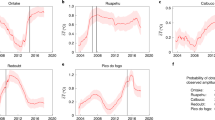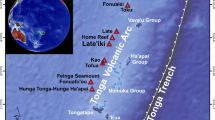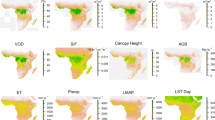Abstract
ACTIVE volcanoes transfer both material and heat to the Earth's surface, but their thermal budgets are more difficult to monitor than their eruption rates, or the output of volatiles. Short-wavelength infrared data from the Landsat Thematic Mapper have been used to measure temperatures1,2, and the logical next step is to measure the total radiant energy flux, Q, in order to monitor changes in thermal budgets with time, and to allow the activity of different volcanoes to be compared. Here we report Thematic Mapper measurements of Q at Lascar volcano, north Chile, for December 1984 that are consistent with the earlier suggestion1 that a lava lake was the source of the anomaly, and values for 1985–86 that are much lower, suggesting that fumarolic activity was then a more likely heat source. Our results show that satellite remote sensing may be used to monitor the activity of a volcano quantitatively, in a way not possible by conventional ground studies, and may provide a method for predicting eruptions.
This is a preview of subscription content, access via your institution
Access options
Subscribe to this journal
Receive 51 print issues and online access
$199.00 per year
only $3.90 per issue
Buy this article
- Purchase on Springer Link
- Instant access to full article PDF
Prices may be subject to local taxes which are calculated during checkout
Similar content being viewed by others
References
Francis, P. W. & Rothery, D. A. Geology 15, 614–617 (1987).
Rothery, D. A., Francis, P. W. & Wood, C. A. J. geophys. Res. 93, 7993–8008 (1988).
Matson, M. & Dozier, J. Photogramm. Engng rem. Sens. 47, 1311–1318 (1981).
Colwell, R. N. Manual of Remote Sensing (American Society of Photogrammetry, Falls Church, Virginia, 1983).
Le Guern, F., Carbonnelle, J. & Tazief, H. J. Volcan. geotherm. Res. 6, 27–48 (1979).
Flynn, L. P., Mouginis-Mark, P. J. & Grade, J. C. Science (submitted).
Francis, P. W. & Mcallister, R. Eos 67, 170–171 (1986).
Francis, P. W. & de Silva, S. L. Rem. Sens. Environ. (in the press).
Glaze, L. S. et al. Bull, volcan. (in the press).
Bonnet, G. Acad. R. Sci. Outra-Mer 6, 709–714 (1960).
Le Guern, F. J. Volcan. geotherm. Res. 31, 17–31 (1987).
McEwen, A. S. et al. J. geophys. Res. 90, 12345–12379 (1985).
Author information
Authors and Affiliations
Rights and permissions
About this article
Cite this article
Glaze, L., Francis, P. & Rothery, D. Measuring thermal budgets of active volcanoes by satellite remote sensing. Nature 338, 144–146 (1989). https://doi.org/10.1038/338144a0
Received:
Accepted:
Issue Date:
DOI: https://doi.org/10.1038/338144a0
This article is cited by
-
Volcanology 2030: will an orbital volcano observatory finally become a reality?
Bulletin of Volcanology (2022)
-
The 2017 Nishinoshima eruption: combined analysis using Himawari-8 and multiple high-resolution satellite images
Earth, Planets and Space (2019)
-
Gas-driven lava lake fluctuations at Erta ’Ale volcano (Ethiopia) revealed by MODIS measurements
Bulletin of Volcanology (2016)
-
A review of algorithms for detecting volcanic hot spots in satellite infrared data
Bulletin of Volcanology (2011)
-
The magmatic- and hydrothermal-dominated fumarolic system at the Active Crater of Lascar volcano, northern Chile
Bulletin of Volcanology (2009)
Comments
By submitting a comment you agree to abide by our Terms and Community Guidelines. If you find something abusive or that does not comply with our terms or guidelines please flag it as inappropriate.



